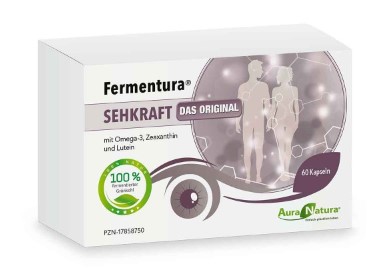Product Description
The intelligent combination of nutrients especially for the eyes: secondary plant substances, omega-3 fatty acids and vitamins!
- Omega-3 fats are essential fatty acids that the body has to get from food because it cannot produce them itself. They are among the polyunsaturated fatty acids and are important building materials not only for the eyes, but for the entire organism.
- Omega-3 fats are divided into: DHA, EPA and ALA. Marine sources such as salmon, mackerel, herring, sardines or algae provide the important fatty acids DHA (docosahexaenoic acid) and EPA (eicosapentaenoic acid). ALA (alpha-linolenic acid), on the other hand, is found in plant sources (linseed oil, walnuts, kale).
- Since the retina of the eye is mainly made up of DHA and the photoreceptor cells also contain DHA, an additional supply of this important fatty acid is appropriate. It also supports the metabolism of the eyes and is needed for tear production. A deficit can lead to dry eyes and blurred vision.
- The EFSA (European Food Safety Authority) also confirms: DHA contributes to the maintenance of normal vision
- The omega-3 in Fermentura® SEHKRAFT is pure schizochytrium algae oil. Schizochytrium are marine microalgae that are cultivated in an environmentally friendly and pollution-free manner to obtain algae oil.
Fermented Kale
- Kale (Brassica oleracea var. sabellica) belongs to the cruciferous family and descends from the wild cabbage. It is a typical winter vegetable, which depending on the region is also called high cabbage, brown cabbage, stalk cabbage or Krauskohl. Its origin is believed to be in Greece. There it was also used as a medicine. Vegetables made their way to Germany around the 16th century. Traditionally, kale is more of a North German affair in this country – which is why it is also known there under regional names such as “Frisian Palme”, ”Oldenburger Palme” or “Palme des Nordens”.
- Hardly any vegetable is as rich in nutrients as kale. In addition to vitamins (vitamins C, A, E, B3, B2, B6, B9, B1, B7), a high-quality amino acid profile, minerals (potassium, calcium, sulfur, phosphorus, chloride, sodium, magnesium), the omega-3 -fatty acid ALA and fiber, it also scores with a lot of secondary plant substances. Above all, the antioxidant strong flavonoids (including quercetin), carotenoids (beta-carotene, lutein and zeaxanthin) and the mustard oil glycosides (glucosinolates). There is also plenty of chlorophyll, which is often referred to as “green blood”. All reasons why the relevant literature has included it in the group of superfoods.
- It is precisely the carotenoids lutein and zeaxanthin that make kale interesting for eye health. Lutein and zeaxanthin are the macula’s own visual pigments. The macula or yellow spot is the point of sharpest vision in the eye. There are also a particularly large number of cones that are responsible for color vision. Lutein and zeaxanthin fulfill important antioxidant tasks at this point.
- Fermentation further increases nutrient content and bioavailability
marigold
- The marigold (Calendulaofficinalis) belongs to the daisy family and is also called gold flower, rain flower or marigold.
- It is one of the best-known medicinal plants in traditional medicine. Already in the herbal books of the Middle Ages it is recommended for eye problems.
- It is full of valuable ingredients such as essential oils, saponins, mucilage, flavonoids and carotenoids. Of particular note is its content of alpha-cadinol, a sesquiterpene known for its anti-inflammatory properties. Lutein and zeaxanthin – the yellow carotenoids – are also represented in large numbers.
astaxanthin
- Astaxanthin belongs to the xanthophyll class in the carotenoid group.
- Astaxanthin occurs naturally in algae and plankton. This is why animals that eat these substances also have a pink color. For example wild salmon or flamingos.
- Astaxanthin is considered a super antioxidant. It is said to have many useful properties for human health. Also in the prevention of damage to the eye.
Carotenoids are divided into two groups: carotenes and xanthophylls. The carotenes include B. the beta-carotene from carrots and the lycopene from tomatoes. The xanthophylls include lutein and zeaxanthin from kale and marigold as well as astaxanthin from algae.
vitamin C
- In the aqueous humor of the eye that surrounds the lens, there is a particularly large amount of vitamin C. In this way, it can protect the lens from oxidation processes.
- Vitamin C contributes to normal energy-yielding metabolism
- Vitamin C contributes to the normal functioning of the nervous system (including the optic nerve).
- Vitamin C helps to protect the cells (including the visual cells) from oxidative stress
Vitamin D
- Contributes to maintaining normal muscle function.
- Contributes to normal blood calcium levels.
Vitamin B6
- Vitamin B6 contributes to normal cysteine synthesis
- Vitamin B6 contributes to a normal energy-yielding metabolism
- Vitamin B6 contributes to the normal functioning of the nervous system
- Vitamin B6 contributes to normal homocysteine metabolism
Vitamin B2
- Riboflavin contributes to normal energy-yielding metabolism
- Riboflavin contributes to the normal functioning of the nervous system
- Riboflavin contributes to the maintenance of normal mucous membranes
- Riboflavin helps maintain normal vision
- Riboflavin helps protect cells from oxidative stress
Vitamin A
- Considered the number 1 eye vitamin
- Helps maintain normal vision.
- Contributes to the maintenance of normal mucous membranes.
Responsible according to Art. 8 Para. 1 of the VO (EU) 1169/2011: NUTROPURE LIMITED, Lordou Vyronos, 61-63, 6023 Larnaca, Cyprus
Ingredients: Algae oil (40% omega-3 (DHA)), capsule shell (bovine gelatine, glycerol, water, dye iron oxide yellow), fermented kale powder (6.2%), calendula officinalis extract (80% lutein), Ascorbic acid, anti-caking agent beeswax, Haematococcus pluvialis extract, emulsifier soy lecithin , anti-caking agent silicon dioxide, calendula officinalis extract (50% zeaxanthin), retinyl palmitate, pyridoxine hydrochloride, riboflavin, cholecalciferol
Recommended dosage: Consume two capsules daily with some liquid.
Notes: The stated recommended daily intake must not be exceeded. Keep out of reach of small children. Dietary supplements should not be used as a substitute for a balanced and varied diet.
